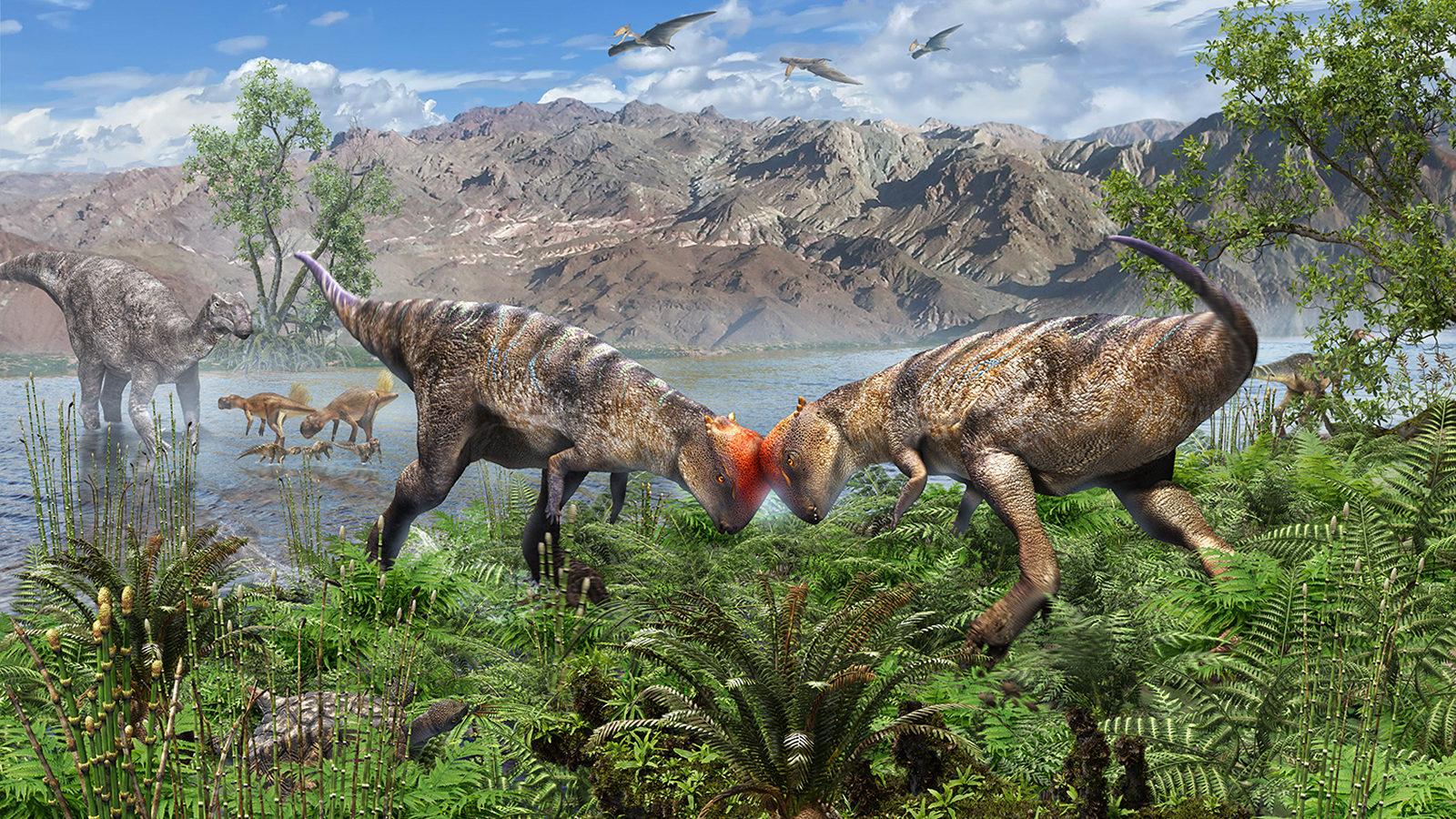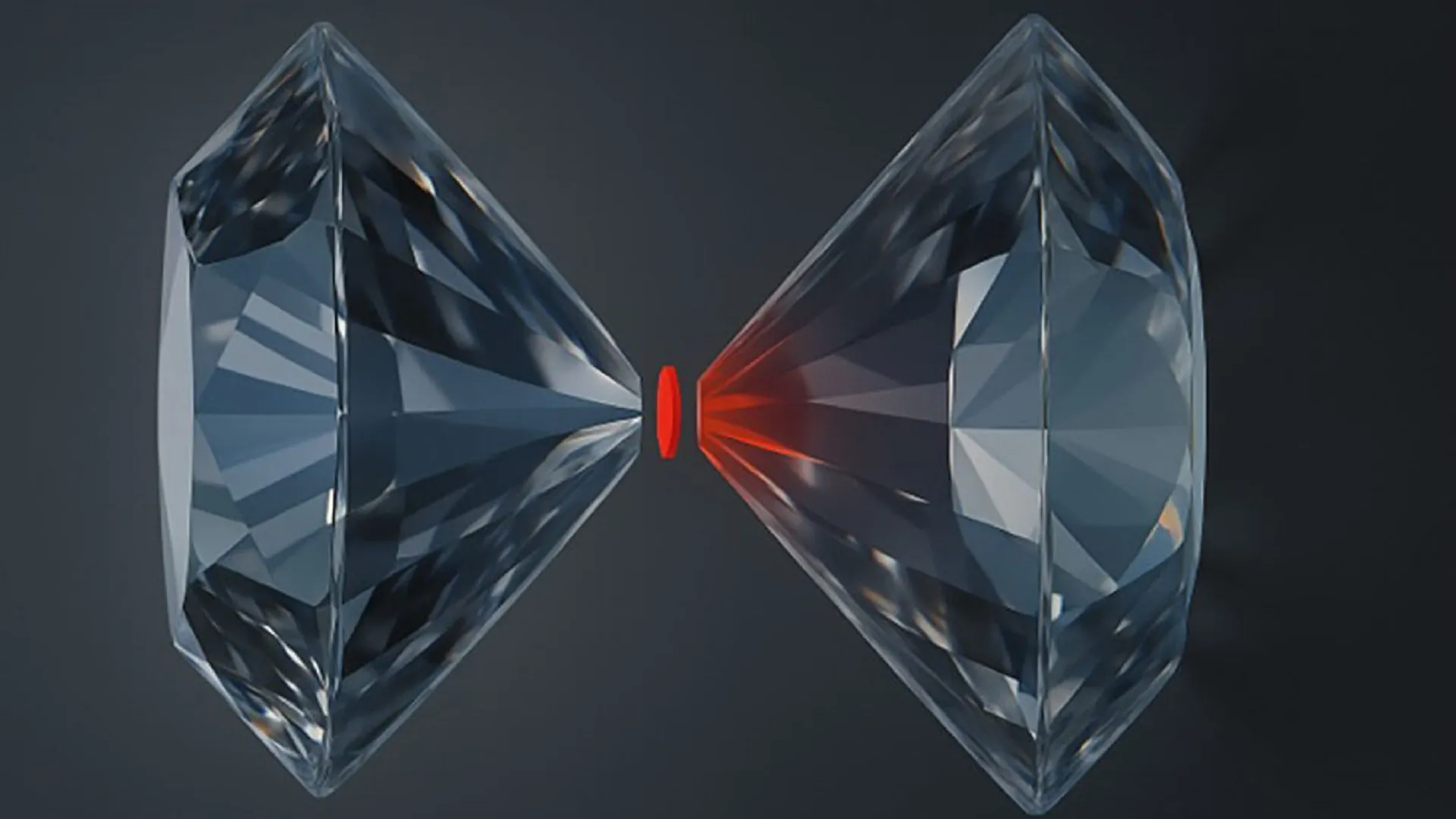Oldest-known dome-headed dinosaur discovered sticking out of a cliff in Mongolia’s Gobi Desert
By Skyler Ware
Copyright livescience

Skip to main content
Close main menu
Live Science
Sign up to our newsletter
View Profile
Search Live Science
Planet Earth
Archaeology
Physics & Math
Human Behavior
Science news
Life’s Little Mysteries
Science quizzes
Newsletters
Story archive
Skyscraper-sized asteroid flyby
Diagnostic dilemma
Elusive ‘grumpy’ cat photographed
Anthropologist Ella Al-Shamahi on human origins
How misinformation spreads
Don’t miss these
‘So weird’: Ankylosaur with 3-foot spikes sticking out of its neck discovered in Morocco
‘Ash-winged dawn goddess’ is oldest pterosaur ever discovered in North America — and it was small enough to sit ‘on your shoulder’
Extinct species
‘Most remarkable’ fossil of Jurassic sea monster from Germany is previously unknown species
T. rex relatives ‘moonwalked’ to attract mates, newfound dinosaur ‘mating arena’ suggests
Scientists find baby pterosaurs died in violent Jurassic storm 150 million years ago
Human Evolution
Mysterious 300,000-year-old Greek cave skull was neither human nor Neanderthal, study finds
70 million-year-old hypercarnivore that ate dinosaurs named after Egyptian god
Archaeology
‘Oddly shaped head’ left in Italian cave 12,500 years ago is Europe’s oldest known case of cranial modification, study finds
Extinct species
‘Beautifully preserved’ ice age horse skull unearthed in Yukon mine
115 million-year-old dinosaur tracks unearthed in Texas after devastating floods
Study raises major questions about Earth’s ‘oldest’ impact crater
Human Evolution
Who were the Denisovans, archaic humans who lived in Asia and went extinct around 30,000 years ago?
Night lizards survived dinosaur-killing asteroid strike despite living right next to impact site
Extinct species
Ancient shark discovered deep inside world’s longest cave system
Human Evolution
Never-before-seen cousin of Lucy might have lived at the same site as the oldest known human species, new study suggests
Extinct species
Oldest-known dome-headed dinosaur discovered sticking out of a cliff in Mongolia’s Gobi Desert
Skyler Ware
17 September 2025
The juvenile pachycephalosaurs, which predates the previous oldest dome-headed dinosaur by 15 million years, reveals more about how and when this unusual feature developed.
When you purchase through links on our site, we may earn an affiliate commission. Here’s how it works.
A juvenile dome-headed dinosaur is the oldest and most complete pachycephalosaur fossil found to date.
(Image credit: Masaya Hattori)
Paleontologists have uncovered the oldest and most complete dome-headed dinosaur fossils to date in Mongolia’s Gobi Desert.
The fossils, which are between 108 million and 115 million years old, push back the timeline for the emergence of dome-head dinosaurs, or pachycephalosaurs, by about 15 million years. The new fossils could also reveal details about the evolution and development of these dinosaurs’ bizarre rounded skulls.
“Pachycephalosaurs are iconic dinosaurs, but they’re also rare and mysterious,” study co-author Lindsay Zanno, a paleontologist at North Carolina State University, said in a statement. These dinos thrived during the Late Cretaceous period (between 86 million and 66 million years ago).
You may like
‘So weird’: Ankylosaur with 3-foot spikes sticking out of its neck discovered in Morocco
‘Ash-winged dawn goddess’ is oldest pterosaur ever discovered in North America — and it was small enough to sit ‘on your shoulder’
‘Most remarkable’ fossil of Jurassic sea monster from Germany is previously unknown species
Some scientists think the thick skulls of pachycephalosaurs helped them attract mates and fend off competition, while others suggest that these weirdos didn’t butt heads, but instead kick-boxed like kangaroos. But how their rounded skulls developed is a mystery. Most known pachycephalosaur fossils are incomplete, and scientists haven’t found many fossils from early in their development.
Now, in a new study, published Wednesday (Sept. 17) in the journal Nature, a group of paleontologists report a fossil that might hold some answers. In eastern Mongolia, the team found the fossilized remains of a dome-headed dinosaur from the Early Cretaceous period (145 million to 100 million years ago). They named the newly discovered species Zavacephalae rinpoche.
The fossil was discovered sticking out of the side of a cliff in Mongolia. (Image credit: North Carolina Museum of Natural Sciences)
Zavacephalae comes from the Tibetan word “zava,” meaning root or origin, and the Latin word “cephal,” meaning head. “Rinpoche” is a Tibetan word meaning “precious one,” so named because the team found the skull sticking out of a cliff like a polished jewel.
The fossil included about 54% of the dinosaur’s bones, including the skull and entire tail, as well as several hand and leg bones and stomach stones that helped Z. rinpoche grind its food. In life, the dinosaur likely measured about 3.3 feet (1 meter) long and weighed about 12.9 pounds (5.85 kilograms).
Sign up for the Live Science daily newsletter now
Get the world’s most fascinating discoveries delivered straight to your inbox.
Contact me with news and offers from other Future brandsReceive email from us on behalf of our trusted partners or sponsorsBy submitting your information you agree to the Terms & Conditions and Privacy Policy and are aged 16 or over.
“We age dinosaurs by looking at growth rings in bones, but most pachycephalosaur skeletons are just isolated, fragmentary skulls,” Zanno said. “Z. rinpoche is a spectacular find because it has limbs and a complete skull, allowing us to couple growth stage and dome development for the first time.”
RELATED STORIES
—Helmet-headed dinosaurs kickboxed like kangaroos, new study suggests
—Like ‘walking through the woods of millions of years ago’: Ancient ecosystem brimming with dinosaur tracks discovered in Alaska
—Mysterious ‘runner’ dinosaur a sign there are more Jurassic secrets to unlock beneath western US
Z. rinpoche’s dome was fully developed, but growth rings in its lower leg bone suggest that the animal was a juvenile and was still growing when it died. Because pachycephalosaurs probably used their domes to attract mates, this suggests that the dinosaur reached sexual maturity before it was fully grown.
“If you need to headbutt yourself into a relationship, it’s a good idea to start rehearsing early,” Zanno said.
“This specimen is a once-in-a-lifetime discovery,” Zanno added. “Z. rinpoche gives us an unprecedented glimpse into the anatomy and biology of pachycephalosaurs.”
Skyler Ware
Social Links Navigation
Live Science Contributor
Skyler Ware is a freelance science journalist covering chemistry, biology, paleontology and Earth science. She was a 2023 AAAS Mass Media Science and Engineering Fellow at Science News. Her work has also appeared in Science News Explores, ZME Science and Chembites, among others. Skyler has a Ph.D. in chemistry from Caltech.
You must confirm your public display name before commenting
Please logout and then login again, you will then be prompted to enter your display name.
‘So weird’: Ankylosaur with 3-foot spikes sticking out of its neck discovered in Morocco
‘Ash-winged dawn goddess’ is oldest pterosaur ever discovered in North America — and it was small enough to sit ‘on your shoulder’
‘Most remarkable’ fossil of Jurassic sea monster from Germany is previously unknown species
T. rex relatives ‘moonwalked’ to attract mates, newfound dinosaur ‘mating arena’ suggests
Scientists find baby pterosaurs died in violent Jurassic storm 150 million years ago
Mysterious 300,000-year-old Greek cave skull was neither human nor Neanderthal, study finds
Latest in Dinosaurs
Scientists find baby pterosaurs died in violent Jurassic storm 150 million years ago
‘So weird’: Ankylosaur with 3-foot spikes sticking out of its neck discovered in Morocco
115 million-year-old dinosaur tracks unearthed in Texas after devastating floods
T. rex relatives ‘moonwalked’ to attract mates, newfound dinosaur ‘mating arena’ suggests
‘Ash-winged dawn goddess’ is oldest pterosaur ever discovered in North America — and it was small enough to sit ‘on your shoulder’
‘It’s how I would imagine I would react if I saw a real-life giant dinosaur’: What Jurassic World Rebirth’s scientific advisor thinks of the movie
Latest in News
Oldest-known dome-headed dinosaur discovered sticking out of a cliff in Mongolia’s Gobi Desert
‘The sun is slowly waking up’: NASA warns that there may be more extreme space weather for decades to come
Scientists invent new sunscreen made from pollen
Anthropologist claims hand positions on 1,300-year-old Maya altar have a deeper meaning
1,900-year-old ‘treasure’ found in Roman-era family’s scorched house in Romania
Grumpy-looking Pallas’s cat photographed by camera trap in stunning photo from eastern Himalayas
LATEST ARTICLES
Scientists invent new sunscreen made from pollen
‘The sun is slowly waking up’: NASA warns that there may be more extreme space weather for decades to come
Anthropologist claims hand positions on 1,300-year-old Maya altar have a deeper meaning
A knife broke off in a man’s chest, and he didn’t notice it for 8 years
‘When people gather in groups, bizarre behaviors often emerge’: How the rise of online social networks has catapulted dysfunctional thinking
Live Science is part of Future US Inc, an international media group and leading digital publisher. Visit our corporate site.
Contact Future’s experts
Terms and conditions
Privacy policy
Cookies policy
Accessibility Statement
Advertise with us
Web notifications
Editorial standards
How to pitch a story to us
Future US, Inc. Full 7th Floor, 130 West 42nd Street,
Please login or signup to comment
Please wait…



